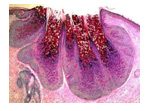Abducens Nerve and Facial Nerve Palsy in the Setting of an Extracranial Mass and Vascular Disease
Case Report
I present a case of a 59-year-old female patient who presented to a primary care clinic in August 2021 after she woke up from a nap with sudden onset horizontal binocular diplopia that worsened on far vision. She also reported a severe left side headache that worsened with loud noises. Gait instability was also noted. Physical exam revealed significant right eye esotropia and left eye CN 6 palsy which did not cross the midline on lateral gaze. Signs of right cranial nerve 7 palsy were seen with right side facial drop and ptosis apparent on inspection. Cranial nerves two and three were deemed to be intact as both pupils reacted equally to light and accommodation. She denied any history of trauma. At this initial visit, the etiology was suspected to be a viral auto-immune sequala and a steroid dose pack was prescribed. Her medical history is significant for hypertension, dyslipidemia, diabetes mellitus, and hypothyroidism. She has a 60-pack year smoking history. CTA in August 2021 was negative for any large vessel occlusion or hemorrhage. MRI was negative for any significant occlusion but revealed an extra-cranial mass, which measured 1cm and impacting the right trigeminal nerve. Subsequent follow up visits in August 2021 revealed no improve after corticosteroid therapy with persistent 6 and 7th nerve palsy, worsening alternating esotropia and further balance issues. No surgical intervention was made and a repeat MRI in 6 months was planned. At that time, the focus of treatment was to improve glycemic control, more tightly control lipids levels, and advise smoking cessation. Nearly three months to the date of onset, the patient awoke with restored lateral gaze and absent diplopia. Her facial palsy improved in subsequent weeks.
Discussion
Even in the presence of a facial palsy mass, vascular risk factors for patients with abducens nerve palsy must be evaluated. In adults, vascular disease constitutes a majority of abducens nerve palsy as shown by a retrospective chart review in 2014 [4]. Major risk factors for cranial atherosclerosis include diabetes mellitus, hypertension, metabolic syndrome, smoking, and a sedentary lifestyle [5]. The right extra-cranial mass was considered a possible etiology of both cranial neuropathies but was subsequently ruled out based on imaging and patient presentation. The patient’s right cranial nerve 7 palsy improved making the compression from a growing mass an unrealistic etiology. In relation to the left abducens nerve palsy, its contralateral location and sudden improvement highlighted the vascular nature of her etiology. A clearly defined etiology for facial palsies proves difficult to find. 70% of unilateral facial palsies are idiopathic with trauma, infection, and neoplasia as the remaining most common causes. In idiopathic cases, a viral prodrome period occurs before the onset of palsy [6].
The patient denied any preceding symptoms making a viral cause less likely but not impossible cause. The facial nerve has a robust vascular supply due to its thick epineurium; this vascular dependency proposes an ischemic connection to facial nerve palsy [7]. Although the facial nerve vascular supply has many anastomoses, this system can be compromised by diabetes mellitus, which is present in this case, especially at certain points along its tract that do have as proficient collateral perfusion as in the stylomastoid and petrosal branches [8]. Concurrent abducens and facial nerve palsies are a very uncommon finding. A 51-patient prospective study on bell’s palsy found that the most common concurrent cranial nerve palsies involved the trigeminal, glossopharyngeal, and hypoglossal nerves [9]. At this time, it is difficult to predict the long-term outcome for the patient presented in this case report but the prognosis for isolated abducens nerve palsy is encouraging. A 213-patient review found that 78.5% experience spontaneous recovery of their symptoms, with 36.6% by 8 weeks [10].
Conclusion
Patients that present with cranial neuropathies require a comprehensive vascular assessment in addition to the evaluation of neoplasms, trauma, and infectious causes. In the setting of a facial palsy, the etiology should not be immediately assumed to be of viral or auto-immune origin especially in diabetes mellitus, which predisposes the facial nerve to microvascular infarct. Multiple concurrent cranial neuropathies further stress the need for the evaluation of vascular risk factors.


No comments:
Post a Comment
Note: Only a member of this blog may post a comment.